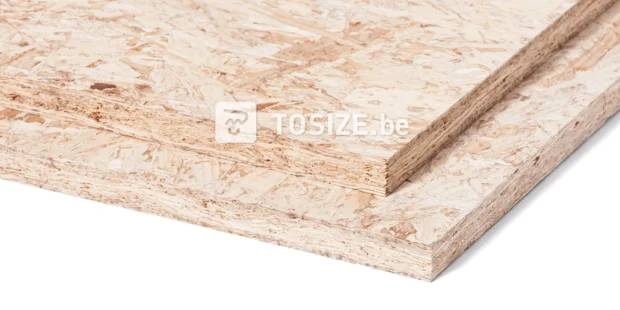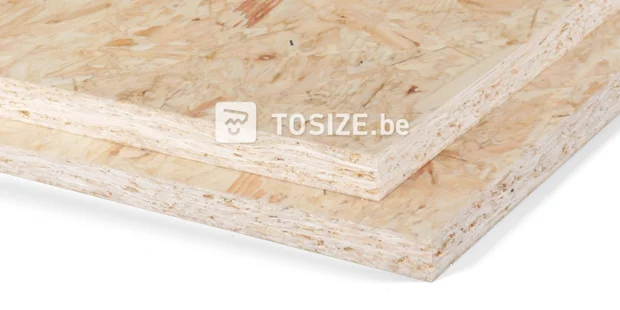OSB boards are structurally strong sheets. Just like MDF and chipboard, OSB is a fibreboard consisting of bonded wood splinters. This sheet material is widely used for e.g. floors, walls, roof elements, facade cladding, temporary fences or panelling. Due to its industrial appearance, OSB is also increasingly used for decorative applications such as furniture, kitchens and tabletops.
Order cut-to-size OSB boards
Order cut-to-size OSB online quickly and easily. Choose the thickness you need and we will accurately cut it to the desired shape and size. OSB cut to size in a circular or oval shape? We cut or mill OSB into various shapes. View all available shapes en finishes.
OSB: What is it?
OSB board is a composite board composed of wood chips and a (moisture-resistant) adhesive. Wood chips that would otherwise be waste are reused to make industrial boards. These coarse wood chips give this sheet material a unique and robust appearance. In addition, it is a sustainable production method. As a result, OSB is growing in popularity and replaces plywood in many cases. In addition, due to its coarse wood chips, OSB also contains less glue than chipboard or MDF. Because of this, you could say that OSB is the most sustainable product compared to other fibreboards.
The structure of OSB boards
OSB is made from pressed wood chips and therefore belongs to the family of fibreboards, just like MDF and chipboard. An OSB sheet usually consists of 3 layers of compressed chips, with the inner layer being oriented crosswise relative to the outer two layers. This makes the board very strong.
Properties of OSB
OSB is commonly used for applications where plywood was previously chosen. In certain areas, OSB has thus taken over the use of plywood. This is mainly due to the advantages of OSB over plywood. For instance, twice as much energy is consumed in the production of plywood as in the production of OSB boards, making OSB a more sustainable alternative.
And thanks to its insulating properties, OSB boards also prevent your neighbours from complaining about noise nuisance. In addition, it is a very strong sheet material that does not warp as easily as plywood.
Types of OSB boards
OSB is available in several variants. OSB 2 and OSB 3. In the case of OSB, the 2 and 3 represent the moisture-repellent properties. Do you want to be able to use the OSB boards in dry and humid conditions for structures that are subjected to heavy loads? Then opt for class OSB 3 or higher.
Our range of OSB boards includes the following types:
-
OSB 3
Different colours and top layers of OSB
In addition to standard OSB, you can also choose OSB with a matt finish. This finished sheet material is flatter than our standard unfinished OSB. Finished OSB is sanded before the coating is applied. This creates a flat and matt look. Where with unfinished OSB, the texture is still clearly perceptible, finished OSB is smooth.
OSB boards and moisture
OSB can be used in dry and slightly damp areas, for example in the bathroom or kitchen. We do not recommend using OSB for outdoor applications.
Available thicknesses of OSB
OSB can be ordered in different thicknesses. You can easily specify your desired thickness while configuring your product. This way you can be sure that the sheet material meets your requirements: both the size and thickness, as well as the shape of the material. In our web shop, you can order OSB 9 mm, OSB 12 mm, OSB 15 mm, OSB 18 mm and have them cut to size.
Common applications of OSB
In addition to being used as a subfloor, OSB is increasingly being used as a decorative sheet material. Due to its durable properties and robust appearance, it fits into any home interior. Think of robust tabletops, tough-looking OSB walls or a shop display made from OSB boards. By using this budget-friendly and durable sheet material in your interior, you give your home an industrial and tough look in no time. Did you know that OSB is also available in lacquered versions? Take a look at all available custom OSB plates in our product range!
DIY tips for assembling and finishing OSB
Are you going to use OSB for decorative applications? Because this sheet material consists of coarse chips, it is important to sand it well. Would you like to keep the rough texture of OSB, but in a different colour? Then apply a lick of paint! This way, you can easily create a beautiful eye-catcher in your home. OSB is easy to machine: sawing, milling, screwing and drilling are no problem at all, and it hardly ever splits.
Alternatives to OSB
Is OSB not what you're looking for? Then opt for plywood or MDF.
OSB or plywood?
One of the frequently used applications of OSB is to make a subfloor. OSB with a tongue and groove finish is perfect for this. Previously, subfloors were often made from plywood, but traditionally, it appears OSB has better properties and characteristics as a subfloor. For instance, due to its insulating properties, OSB boards prevent your neighbours from complaining about noise nuisance. In addition, it is a strong sheet material that does not warp as easily as plywood. OSB is also easy to machine: sawing, milling, screwing and drilling are no problem at all, and it hardly ever splits.
OSB or MDF?
If you are in love with the texture of OSB, your list of alternatives does not include MDF. Nevertheless, MDF is one of the most widely used and versatile types of sheet material. OSB is an all-in-one board with a coarse structure. Easy to assemble and with moisture-repellent properties. MDF also has these properties, but has a fine structure and smooth surface. MDF for outdoor use is also available, which is not the case for OSB.
Curious about the other sheet materials in our range? View our entire range of wooden sheets; everything can be cut or milled to size down to the millimetre and you can find the ideal wood type for your next project.



